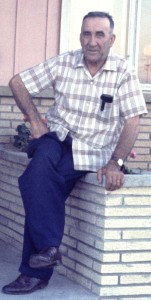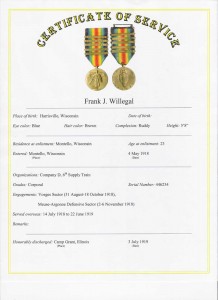My Grandfather was a World War 1 veteran. I only talked to him once about his war experiences. He was a truck driver and told me how he used to get those old trucks up to a speed of 60 miles an hour. I also remember him saying that the army in World War 1 was the last good army or something to that effect. I’m not exactly sure why he held that opinion, but he wasn’t bashful about making the claim. My Grandfather also showed me some trench art that he had made out of some cartridge cases. I wish I knew where that trench art was. Hopefully someone in the family got a hold of it, after he passed away.
I learned a little bit about my grandfather from my dad. He once told me that Grandfather mentioned that when they were being shelled by the German artillery, that they would take cover in the ditches by the side of the road. I was once visiting Circus World Museum with my dad, and he mentioned that the trucks in the circus train display would be similar to those trucks my Grandfather drove in World War 1. I think the Circus World trucks are Mack AC’s, which were indeed, used in World War 1 by the British and Americans. I don’t know for sure that this is the type of truck he drove, but it’s possible. The Mack AC’s have a rated speed of 18 miles per hour. Another army truck of the time, the famous Liberty Truck, was only supposed to reach 15 miles per hour. I wonder what my Grandfather was doing to get up to 60 miles per hour.
My sister did some online searches and found a few records, including this certificate of service which she found at the Wisconsin’s Veteran’s Office.
It turns out that he was a member of the Sixth Infantry Division. The medal depicted at the top of the certificate is the World War 1 victory medal. He is given credit for participating in Vosges Sector (Aug 31, 1918 – Oct 18, 1918) and the Meuse-Argonne Defensive Sector (November 2-6, 1918). The other interesting thing is how quickly he was moved into the combat zone. He joined the army on May 4th, 1918 and was overseas by July 14, 1918. By August 31st, the 6th Division was on the front lines.
There is some information on the Sixth Infantry Division in World War 1 at this site. The Sixth Infantry Division site focuses on the World War II, but there are a few tidbits about the Division’s activities in World War 1. The interesting thing is that this brief history mentions how the division was involved in marches that were subject to German artillery fire, just like my grandfather told my father.
My research on the Sixth Infantry shows that they did a lot of marching, during which time, they picked up the nickname, “The Sightseeing Sixth”. Like most new American divisions, after training they were moved to the relatively quiet Vosges Sector in order to become adapted to actual combat conditions. Here is website with some information about the Vosges Sector. They were in reserve at the end of the war. Apparently they were about to be committed to the Meuse-Argonne offensive, when, rather unexpectedly, the war ended.
The Meuse-Argonne offensive was a very bloody affair. Who knows, I may not be here, if the war had lasted much longer and the Sixth Infantry ended up being committed to that fight. I plan upon putting together a blog entry comparing the Meuse-Argonne offensive of World War 1, with the biggest American battle of World War II.


